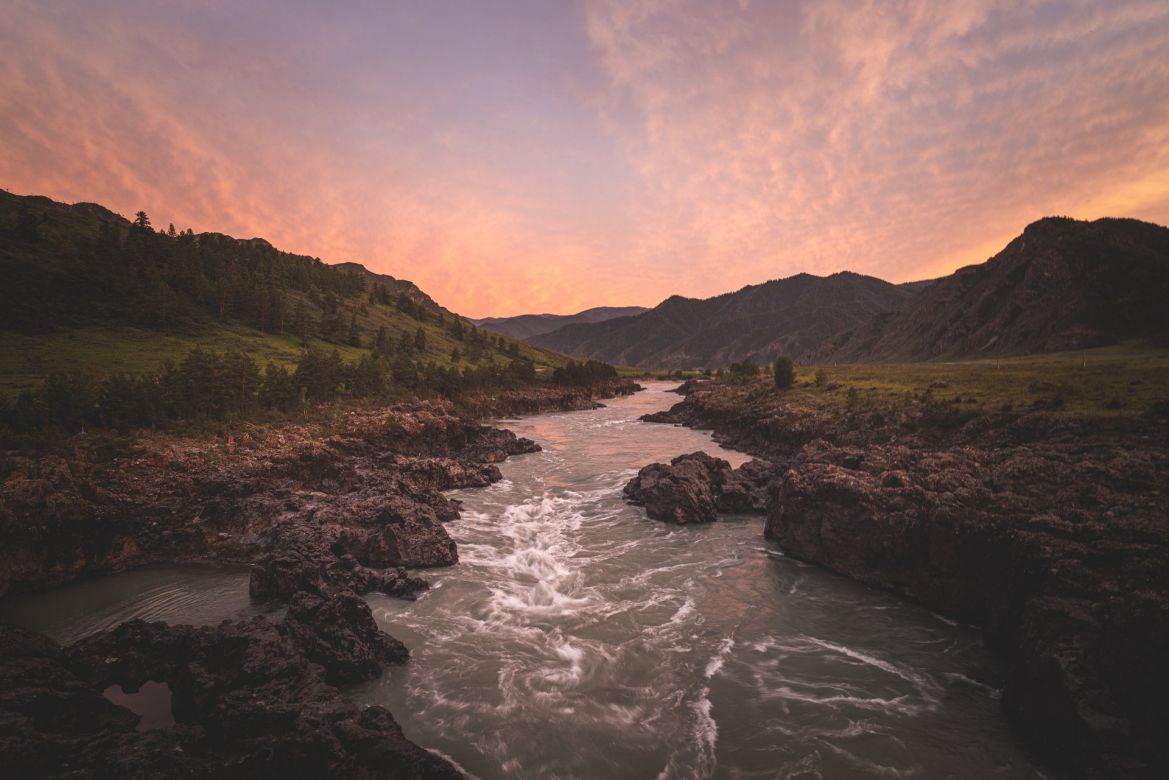Nature
Road Trips
The land of unusual bridges, decent hotels, and untamed Altai wapiti: what to see in the most touristy part of Altai so as not to be disappointed.

Chemal translates from Altai as ‘anthill’, and one can clearly sense a serendipitous streak in this name given to the village at the end of the 18th century when fugitive peasants settled at the mouth of the river. Today, Chemal is the capital of the tourist Altai and, indeed, in comparison with the Chulyshmanskaya River valley or Aktash, it is truly an anthill. Of course, the reason for this lies not as much in the prophetic name as in the mildest climate in Siberia. Here you will encounter not wild steppe swelter but sandy beaches, bountiful fruit orchards, more or less well-designed infrastructure and, predictably, an abundance of aggravating southern hallmarks: tawdry billboards, toll roads and bridges, obsessive knick-knack pedlars, and a host of noisy holidaymakers who come here to have fun, with all their Russian soul’s might. Fortunately, there are also plenty of marvels around Chemal.
The Oroktoy Bridge
The suspension bridge, 95m long and only 3m wide, is located over the narrowest and deepest part of the Katun, with the depth reaching 80m in some places. The view is spectacular. The bridge, paid for by private individuals, was built in 1997 to replace the wooden bridge destroyed by floods. A breathtaking view of the Teldekpen Rapids opens up from here. The rapids, which are among the longest and most scenic on the Katun, are situated in a long rocky corridor that was formed in a tectonic fault. In summer, all sorts of adrenaline junkies sail down them towards Chemal in rafts, kayaks, and catamarans. There are many sandy beaches nearby. And only 11km to the south, right across from the village of Kuyus, on the edge of a high hill – there is an observation deck with a gazebo and a sculpture of the symbol of these parts, a wapiti.

Life Hack
There is a wapiti farm belonging to the Yanykanov family, who, by the way, built the new Oroktoy Bridge with their own money. Don’t hold your breath – the enclosure is enormous and the deer may as well be grazing in a copse of trees on the other side of the mountain, and thus avoid the encounter. Do not worry though, next time it will certainly work out but for now, make sure to get farm-manufactured deer antler products and souvenirs, and head back to take a restorative antler solution bath.

Patmos Island and the Church of St John the Theologian
Legend has it John the Evangelist had a vision (sent down heaven knows where from) of two temples floating above the water: one in the Mediterranean Sea, the other in the Altai hinterland. Therefore the Altai island was not named Patmos by chance but after the Greek island, where John the Theologian once had the honour to live and pray, and where there is also a temple in his name. The Altai Patmos is a small cliff island with steep faces that previously could only be reached by sailing across the turbulent waters of the Katun. These days, you can get there by crossing a suspension bridge floating above the river, as prophesied. From this bridge, by the way, you can clearly see the face of the Mother of God, which was carved in the rock by the sculptor – a nun of the Znamensky Monastery. The island was consecrated back in 1855, but it was only in 1915 that the Church of St John the Theologian built in Chemal by the Altai Spiritual Mission was moved here. After the Russian Revolution, the temple was destroyed in the best Bolshevik tradition and was only restored in 2000. The famous Chemal hydroelectric power station is located not far from Patmos; it was the first hydroelectric power station launched in Siberia in 1935, and today it is an entertaining open-air museum.
The Dragon's Teeth
On the way back to Chemal, get the bridges out of your system by riding down the Dragon’s Teeth Bridge overlooking the eponymous rocky river islands, ominously bristling their sharp angles in the middle of the Katun. Legend, obligatory in these parts, has it that once upon a time the hero Sartakpay walked in the vicinity of the modern village of Elekmonar, and equally liked the places on the right and left banks of the Katun. And, deep in thought, he broke off an impressive piece of rock, crushed it in his palm and threw it into the river. Thus, the sharp rocks appeared in the middle of the turbulent stream – and one of them became a bridge abutment, courtesy of modern craftsmen.
Life Hack
You can have lunch at the pleasant Altay Sense hotel restaurant – they serve excellent food with a view on the Katun, and dine in Chemal – at a cosy cafe at Chemalka guest house.





 7 min
7 min